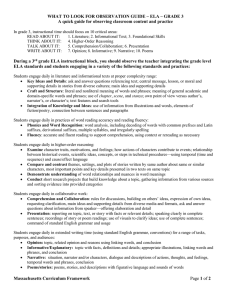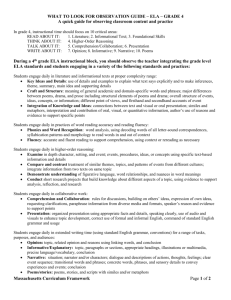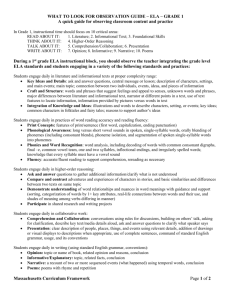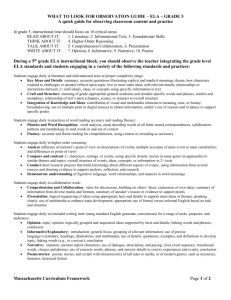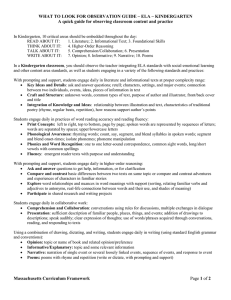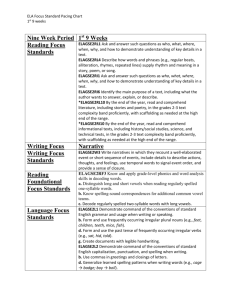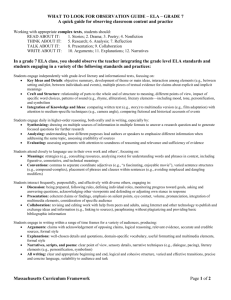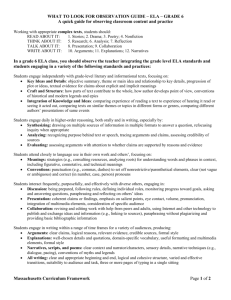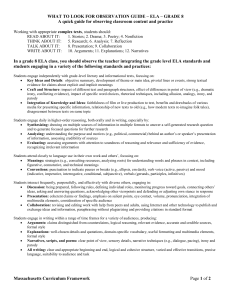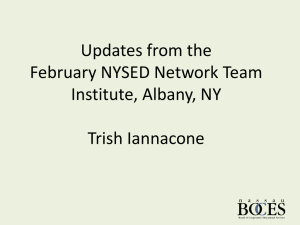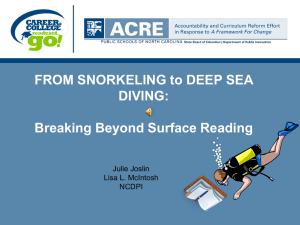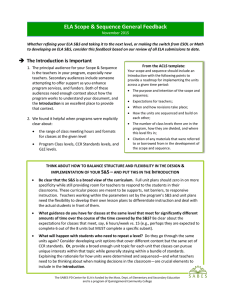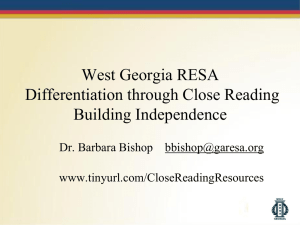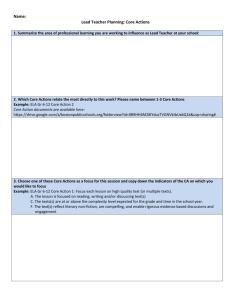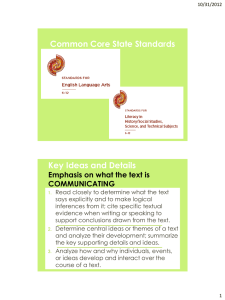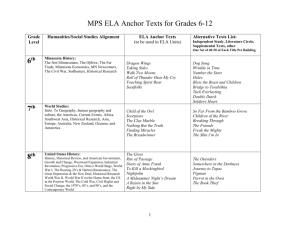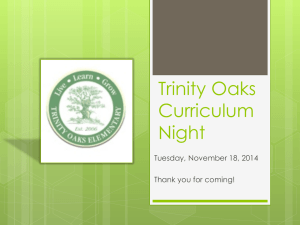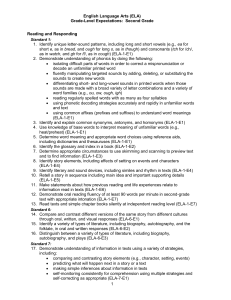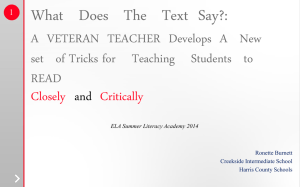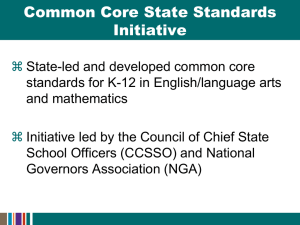What To Look For ELA Grade 2
advertisement
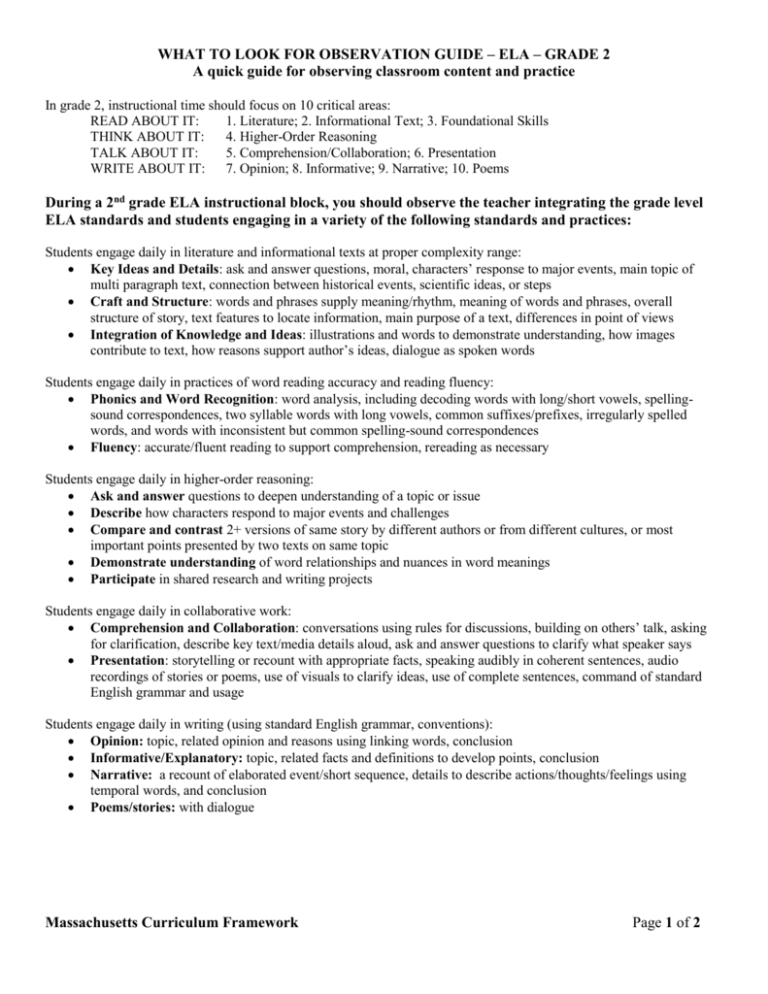
WHAT TO LOOK FOR OBSERVATION GUIDE – ELA – GRADE 2 A quick guide for observing classroom content and practice In grade 2, instructional time should focus on 10 critical areas: READ ABOUT IT: 1. Literature; 2. Informational Text; 3. Foundational Skills THINK ABOUT IT: 4. Higher-Order Reasoning TALK ABOUT IT: 5. Comprehension/Collaboration; 6. Presentation WRITE ABOUT IT: 7. Opinion; 8. Informative; 9. Narrative; 10. Poems During a 2nd grade ELA instructional block, you should observe the teacher integrating the grade level ELA standards and students engaging in a variety of the following standards and practices: Students engage daily in literature and informational texts at proper complexity range: Key Ideas and Details: ask and answer questions, moral, characters’ response to major events, main topic of multi paragraph text, connection between historical events, scientific ideas, or steps Craft and Structure: words and phrases supply meaning/rhythm, meaning of words and phrases, overall structure of story, text features to locate information, main purpose of a text, differences in point of views Integration of Knowledge and Ideas: illustrations and words to demonstrate understanding, how images contribute to text, how reasons support author’s ideas, dialogue as spoken words Students engage daily in practices of word reading accuracy and reading fluency: Phonics and Word Recognition: word analysis, including decoding words with long/short vowels, spellingsound correspondences, two syllable words with long vowels, common suffixes/prefixes, irregularly spelled words, and words with inconsistent but common spelling-sound correspondences Fluency: accurate/fluent reading to support comprehension, rereading as necessary Students engage daily in higher-order reasoning: Ask and answer questions to deepen understanding of a topic or issue Describe how characters respond to major events and challenges Compare and contrast 2+ versions of same story by different authors or from different cultures, or most important points presented by two texts on same topic Demonstrate understanding of word relationships and nuances in word meanings Participate in shared research and writing projects Students engage daily in collaborative work: Comprehension and Collaboration: conversations using rules for discussions, building on others’ talk, asking for clarification, describe key text/media details aloud, ask and answer questions to clarify what speaker says Presentation: storytelling or recount with appropriate facts, speaking audibly in coherent sentences, audio recordings of stories or poems, use of visuals to clarify ideas, use of complete sentences, command of standard English grammar and usage Students engage daily in writing (using standard English grammar, conventions): Opinion: topic, related opinion and reasons using linking words, conclusion Informative/Explanatory: topic, related facts and definitions to develop points, conclusion Narrative: a recount of elaborated event/short sequence, details to describe actions/thoughts/feelings using temporal words, and conclusion Poems/stories: with dialogue Massachusetts Curriculum Framework Page 1 of 2 WHAT TO LOOK FOR OBSERVATION GUIDE – ELA – GRADE 2 ELA What to Look For Guide The practices below, which fall under Standards I and II of the MA Model Teacher Rubric, should be evident in planning and instruction. Any particular lesson will demonstrate some of the practices, not all. For each lesson, artifacts or observables might include: lesson plan, tasks and assessments, teacher instruction, student discussion and behavior, or student work. Student Practices Teacher Practices Standards-based Learning Standards-based Instruction Read and comprehend complex texts (or excerpts) from a variety of text structures. Use newly learned vocabulary when speaking. Apply grade level phonics/word analysis skills when reading. Engage in meaningful writing that is aligned with grade level standards. Ownership of Learning Question, contribute, and collaborate throughout the lesson. Ask clarifying and open-ended questions of their teacher(s) and peers to examine their thinking and develop a deeper understanding of content. Demonstrate ability to independently sustain interaction in order to complete tasks (e.g., during whole group, small group, centers, etc.). Communicate standards (objectives) in a clear, explicit way. Communicate and support language objectives for English Language Learners (ELLs) in a clear, explicit way. Teach standards in context and integrate the standards throughout the day. Explicitly connect previously taught objectives to current lesson. Provide mentor texts, exemplars, and rubrics. Research-based Instruction Provide multiple authentic opportunities for students to practice new skills and vocabulary. Provide explicit and systematic instruction, modeling, checking for understanding, and independent practice, with immediate and corrective feedback. Use of Data to Inform Instruction Differentiate materials, instruction, objectives, and/or content—based on student needs, data, ELL status, IEPs, etc.—to support students in meeting/exceeding grade-level curriculum expectations. Group students based on data and adjust grouping as needed. NOTES: See the full set of Standards and Indicators in ESE’s Model Teacher Rubric (http://www.doe.mass.edu/edeval/model/PartIII_AppxC.pdf). Massachusetts Curriculum Framework Page 2 of 2
